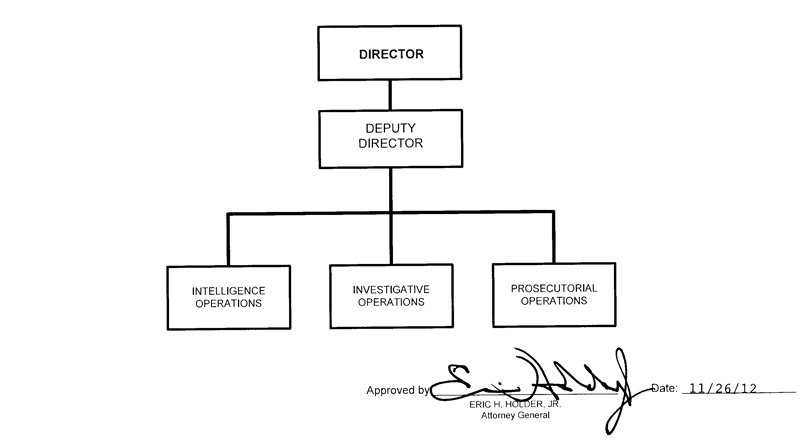Executive Office for Organized Crime Drug Enforcement Task Forces
- Director
- Deputy Director
- Intelligence Operations
- Investigative Operations
- Prosecutorial Operations
- Deputy Director
Approved by Eric H. Holder, Jr., Attorney General
November 26, 2012
History
The Organized Crime Drug Enforcement Task Forces (OCDETF) was created by Presidential Order in 1982 to address the need for coordinated federal government efforts against drug trafficking organizations. In October 1982, President Ronald Reagan announced a new prosecutor-coordinated federal government effort bringing together prosecutors, law enforcement agencies and, when applicable, Department of Defense (DOD) capabilities, to conduct criminal enterprise investigations attacking the command-and-control elements of the drug trafficking organizations responsible for moving massive quantities of illicit narcotics into the United States.
Transnational criminal organizations present an increased and varied threat to the United States. Over the last 40 years, as these criminal networks have grown more sophisticated — branching out to more varied types of criminal activity. The Department of Justice has responded by expanding the OCDETF mission and information sharing authorities beyond targeting drug trafficking organizations and money laundering networks to pursuing all forms of transnational organized crime.
Mission
The mission of OCDETF is to disrupt and dismantle transnational criminal organizations that present priority threats to the public safety, national security, and economic prosperity of the United States.
OCDETF is a mechanism for the agile priority targeting of existing and emergent threats, and is fully engaged in identifying, investigating, and prosecuting criminal networks that commit a broad array of criminal offenses, including narcotics trafficking, illicit finance, human smuggling and trafficking, organized retail crime, sophisticated financial fraud, cyber-enabled crime, firearms trafficking, export violations, government benefits theft, business e-mail compromise, other federal criminal offenses, and U.S. sanctions evasion.
Major Functions
The major functions of OCDETF are to:
- Provide national-level oversight, program governance, policy direction, coordination, and resourcing for personnel and law enforcement operations at 93 U.S. Attorneys’ Offices; 11 federal law enforcement agencies from the Departments of Justice, Homeland Security, Treasury, State, Labor, Postal, and (when applicable) DOD; 19 OCDETF Co-located Strike Forces; the OCDETF Fusion Center; and the International Organized Crime Intelligence and Operations Center. The keystone of OCDETF’s comprehensive strategy is the prosecutor-led, multi-agency task force governance structure.
- Initiate and synchronize intelligence-driven, multi-agency, multi-jurisdictional investigations and prosecutions against transnational criminal networks posing priority threats to the United States. OCDETF provides a forward leaning governance structure for federal, state, and local law enforcement to work together and leverage each other’s legal authorities, expertise, and specialized skills in coordinated, long-term enterprise investigations. The OCDETF strategy recognizes that law enforcement agencies working together led by experienced prosecutors to conduct criminal enterprise investigations, accomplish more than the same agencies working separately.
- Identify, disrupt, and dismantle transnational criminal organizations that threaten the United States. OCDETF leads and manages multi-agency vetting processes to identify national and regional organizations that present the highest priority threats throughout the United States. These organizations are extremely complex and engage in a broad array of criminal activity. Their members traffic in illegal and dangerous drugs; launder illicit proceeds; arm themselves with and traffic in firearms; manipulate our financial, securities, and commodities markets; victimize large swaths of our citizens, private industry, and government agencies through targeted cyber intrusions; kidnap and traffic humans; continue their criminal activities as fugitives; perpetuate violence; support terrorists and hostile governments; and engage in other serious criminal activities.
- Attack the financial infrastructure that supports transnational criminal organizations. OCDETF prosecutors and agents employ an enterprise theory of investigation to target every component of criminal groups and pursue all operational aspects and revenue streams so that targeted organizations cannot recuperate and reconstitute. The linchpin in this approach is the use of asset forfeiture laws to deprive targets of their illegally acquired profits no matter where those profits have been hidden. By disrupting and dismantling every component of the criminal networks operating in or affecting the United States, OCDETF protects the safety and security of Americans and reduces threats to our nation’s infrastructure and stability.
- Enhance and expand the sharing of information across law enforcement agencies to maximize the collective understanding of criminal network threats and inform strategic enforcement actions. The OCDETF Fusion Center (OFC) is an intelligence center that gathers, stores, and analyzes data from twenty-six law enforcement and regulatory agencies to create comprehensive intelligence pictures of targeted organizations, and pass actionable leads to the field. The OFC produces both tactical and operational intelligence products for use in the field, drawing from law enforcement and intelligence data that historically has not been widely shared. In addition, the OFC provides support to the development of strategic intelligence products to enhance threat analysis and support national strategic efforts against transnational organized crime.
Learn about OCDETF Strike Forces


